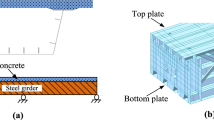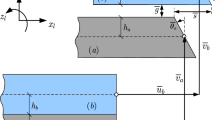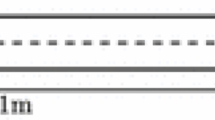Abstract
In this paper, the Kant higher-order beam theory is applied to model each segment of the partial-interaction composite beams, aiming to capture as possible fidelity as the plane stress model. On this basis, the weak-form equation is obtained through the principle of virtual work. Besides, the weak-form quadrature element (WQE), as a counterpart of the conventional finite element (CFE), is derived and implemented to more efficiently solve problems, including free vibration eigenvalue analysis and dynamic responses prediction to moving loads. After the verification of all the programs developed, a series of numerical examples are given to investigate the WQE’s superiority on convergence rate and numerical smoothness over the CFE. At the end of the paper, the influences of structural damping and loads’ moving speed on impact factor of two-span continuous beams are analyzed. Numerical results show that the proposed WQE, due to the variable-order interpolation of the element, possesses overwhelmingly higher computational efficiency than the CFE, and the numerical smoothness problem in the internal force analysis is significantly alleviated by WQE method.




















Similar content being viewed by others
References
Newmark, N.M., Siess, C.P., Viest, I.M.: Tests and analysis of composite beams with incomplete interaction. Proc. Soc. Exp. Stress Anal. 9(1), 75–92 (1951)
Xu, R., Wang, G.: Variational principle of partial-interaction composite beams using Timoshenko’s beam theory. Int. J. Mech. Sci. 60(1), 72–83 (2012)
Xu, R., Wang, G.: Bending solutions of the Timoshenko partial-interaction composite beams using Euler–Bernoulli solutions. J. Eng. Mech., ASCE 139(12), 1881–1885 (2013)
Ecsedi, I., Baksa, A.: Analytical solution for layered composite beams with partial shear interaction based on Timoshenko beam theory. Eng. Struct. 115, 107–117 (2016)
Schnabl, S., Saje, M., Turk, G., Planinc, I.: Analytical solution of two-layer beam taking into account interlayer slip and shear deformation. J. Struct. Eng., ASCE 133(6), 886–894 (2007)
Ranzi, G., Bradford, M.A.: Direct stiffness analysis of a composite beam-column element with partial interaction. Comput. Struct. 85(15–16), 1206–1214 (2007)
Nguyen, Q.-H., Martinelli, E., Hjiaj, M.: Derivation of the exact stiffness matrix for a two-layer Timoshenko beam element with partial interaction. Eng. Struct. 33(2), 298–307 (2011)
Hou, H., He, G.: Static and dynamic analysis of two-layer Timoshenko composite beams by weak-form quadrature element method. Appl. Math. Model. 55, 466–483 (2018)
Chakrabarti, A., Sheikh, A.H., Griffith, M., Oehlers, D.J.: Dynamic response of composite beams with partial shear interaction using a higher order beam theory. J. Struct. Eng., ASCE 139(1), 47–56 (2013)
Chakrabarti, A., Sheikh, A.H., Griffith, M., Oehlers, D.J.: Analysis of composite beams with partial shear interactions using a higher order beam theory. Eng. Struct. 36, 283–291 (2012)
Reddy, J.N.: A simple higher-order theory for laminated composite plates. J. Appl. Mech. 51(4), 745–752 (1984)
He, G., Yang, X.: Dynamic analysis of two-layer composite beams with partial interaction using a higher order beam theory. Int. J. Mech. Sci. 90, 102–112 (2015)
He, G., Yang, X.: Analysis of higher order composite beams by exact and finite element methods. Struct. Eng. Mech. 53(4), 625–644 (2015)
He, G., Yang, X.: Finite element analysis for buckling of two-layer composite beams using Reddy’s higher order beam theory. Finite Elem. Anal. Des. 83, 49–57 (2014)
Manjunatha, B.S., Kant, T.: New theories for symmetric/unsymmetric composite and sandwich beams with C\(^{0}\) finite elements. Compos. Struct. 23(1), 61–73 (1993)
Kant, T., Owen, D.R.J., Zienkiew, O.C.: A refined higher-order C\(^{0}\) plate bending element. Compos. Struct. 15(2), 177–183 (1982)
Kant, T., Gupta, A.: A finite element model for a higher-order shear-deformable beam theory. J. Sound Vib. 125(2), 193–202 (1988)
Kroker, A.M.: Becker W Closed-form analysis of a higher-order composite box beam theory. Proc. Appl. Math. Mech. 9(1), 213–214 (2009)
Kroker, A.M.: Becker W A higher-order composite beam theory for closed-form analysis of beams with box and I cross-section. Proc. Appl. Math. Mech. 10(1), 179–180 (2010)
Carrera, E., Pagani, A.: Analysis of reinforced and thin-walled structures by multi-line refined 1D/beam models. Int. J. Mech. Sci. 75, 278–287 (2013)
Carrera, E., Cinefra, M., Petrolo, M., Zappino, E.: Finite Element Analysis of Structures Through Unified Formulation. Wiley, New Delhi (2014)
Carrera, E., Giunta, G., Petrolo, M.: Beam Structures Classical and Advanced Theories. Wiley, London (2011)
Szabo, B.A., Mehta, A.K.: \(p\)-convergent finite element approximations in fracture mechanics. Int. J. Numer. Methods Eng. 12(3), 551–560 (1978)
Pozrikidis, C.: Introduction to Finite and Spectral Element Methods Using Matlab. CRC Press, New York (2014)
Wang, X.: Differential Quadrature and Differential Quadrature Based Element Methods Theory and Applications. Butterworth-Heinemann, Oxford (2015)
Shu, C., Richards, B.E.: Application of generalized differential quadrature to solve two-dimensional incompressible Navier–Stokes equations. Int. J. Numer. Methods Fluids 15(15), 791–798 (1992)
Zhong, H., Wang, Y.: Weak form quadrature element analysis of Bickford Beams. Eur. J. Mech. A-Solid 29(5), 851–858 (2010)
Zhang, R., Zhong, H.: Weak form quadrature element analysis of planar slender beams based on geometrically exact beam theory. Arch. Appl. Mech. 83(9), 1309–1325 (2013)
Zhong, H., Zhang, R., Xiao, N.: A quaternion-based weak form quadrature element formulation for spatial geometrically exact beams. Arch. Appl. Mech. 84(12), 1825–1840 (2014)
Zhang, R., Zhong, H.: Weak form quadrature element analysis of spatial geometrically exact shear-rigid beams. Finite Elem. Anal. Des. 87, 22–31 (2014)
Jin, C., Wang, X.: Accurate free vibration analysis of Euler functionally graded beams by the weak form quadrature element method. Compos. Struct. 125, 41–50 (2015)
Wang, Y., Wang, X.: Free vibration analysis of soft-core sandwich beams by the novel weak form quadrature element method. J. Sandw. Struct. Mater. 18(3), 294–320 (2016)
Wang, X., Yuan, Z.: A novel weak form three-dimensional quadrature element solution for vibrations of elastic solids with different boundary conditions. Finite Elem. Anal. Des. 141, 70–83 (2018)
Shen, Z., Zhong, H.: Static and vibrational analysis of partially composite beams using the weak-form quadrature element method. Math. Probl. Eng. 2012, 1–23 (2012)
Zhong, H., Yue, Z.: Analysis of thin plates by the weak form quadrature element method. Sci. China Ser. G. 55(5), 861–871 (2012)
Liao, M., Zhong, H.: Application of a weak form quadrature element method to nonlinear free vibrations of thin rectangular plates. Int. J. Struct. Stab. Dyn. 16(1), 1–12 (2016)
Zhang, R., Zhong, H.: Weak form quadrature element analysis of geometrically exact shells. Int. J. Nonlinear Mech. 71, 63–71 (2015)
Yuan, S., Zhong, H.: Consolidation analysis of non-homogeneous soil by the weak form quadrature element method. Comput. Geotech. 62, 1–10 (2014)
Yuan, S., Zhong, H.: A weak form quadrature element formulation for coupled analysis of unsaturated soils. Comput. Geotech. 76, 1–11 (2016)
Liu, B., Ferreira, A.J.M., Xing, Y.F., Neves, A.M.A.: Analysis of functionally graded sandwich and laminated shells using a layerwise theory and a differential quadrature finite element method. Compos. Struct. 136, 546–553 (2016)
Liu, B., Ferreira, A.J.M., Xing, Y.F., Neves, A.M.A.: Analysis of composite plates using a layerwise theory and a differential quadrature finite element method. Compos. Struct. 156, 393–398 (2016)
Wang, X., Yuan, Z., Jin, C.: Weak form quadrature element method and its applications in science and engineering: A state-of-the-art review. ASME Appl. Mech. Rev. 69(3), 030801 (2017)
Bellman, R., Kashef, B.G., Casti, J.: Differential quadrature: a technique for the rapid solution of nonlinear partial differential equations. J. Comput. Phys. 10, 40–52 (1972)
Bellman, R.E., Casti, J.: Differential quadrature and long-term integration. J. Math. Anal. Appl. 34(2), 235–238 (1971)
Jin, C., Wang, X., Ge, L.: Novel weak form quadrature element method with expanded Chebyshev nodes. Appl. Math. Lett. 34, 51–59 (2014)
Bathe, K.J.: Finite Element Procedures. Prentice-Hall, Upper Saddle River (1996)
Huang, C.W., Su, Y.H.: Dynamic characteristics of partial composite beams. Int. J. Struct. Stab. Dyn. 8(4), 665–685 (2008)
Author information
Authors and Affiliations
Corresponding author
Additional information
Publisher's Note
Springer Nature remains neutral with regard to jurisdictional claims in published maps and institutional affiliations.
Rights and permissions
About this article
Cite this article
Fu, C., Yang, X. Dynamic analysis of partial-interaction Kant composite beams by weak-form quadrature element method. Arch Appl Mech 88, 2179–2198 (2018). https://doi.org/10.1007/s00419-018-1443-1
Received:
Accepted:
Published:
Issue Date:
DOI: https://doi.org/10.1007/s00419-018-1443-1




